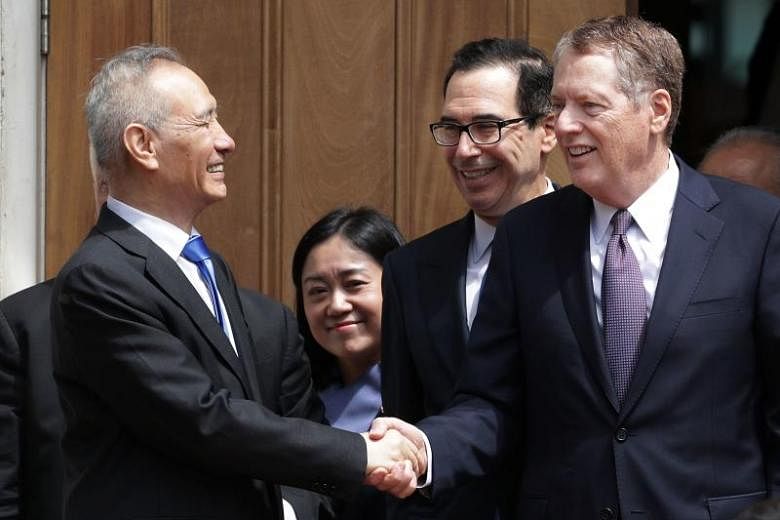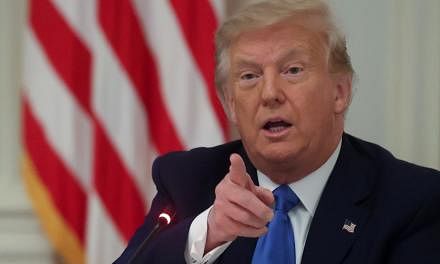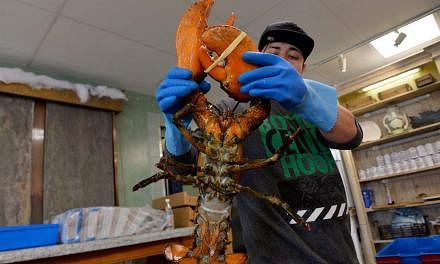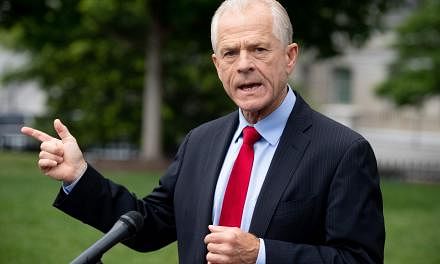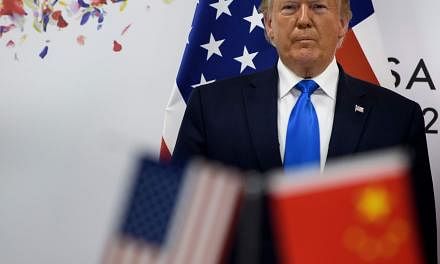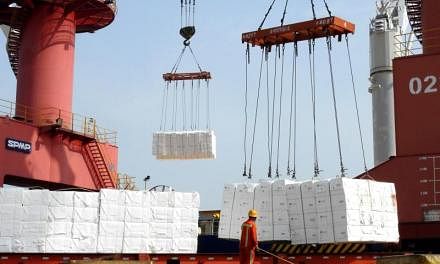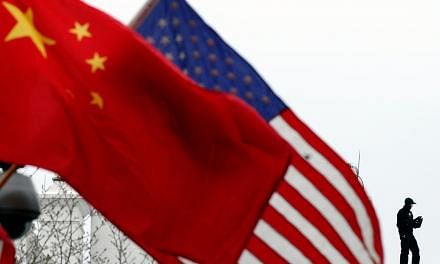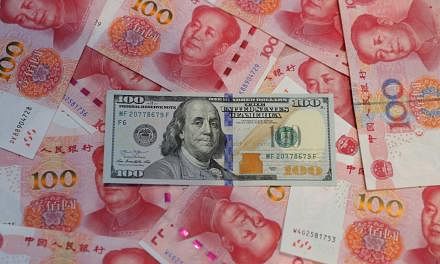WASHINGTON/BEIJING (REUTERS) - US President Donald Trump said on Friday (May 10) trade talks with China would continue even after Washington moved to increase tariffs on Chinese imports, avoiding the worst-case scenario of a complete breakdown in negotiations.
Trump's remarks, which were made in a tweet, followed the end of talks in Washington between US Trade Representative Robert Lighthizer, US Treasury Secretary Steven Mnuchin and Chinese Vice-Premier Liu He.
"Over the course of the past two days, the United States and China have held candid and constructive conversations on the status of the trade relationship between both countries," Trump said, praising his relationship with Chinese President Xi Jinping and saying the negotiations would carry on.
"In the meantime, the United States has imposed Tariffs on China, which may or may not be removed depending on what happens with respect to future negotiations!" the US president said.
The United States early on Friday increased its tariffs on US$200 billion (S$272 billion) in Chinese goods to 25 per cent from 10 per cent, rattling financial markets already worried the 10-month trade war between the world's two largest economies could spiral out of control.
China is expected to retaliate.
The tariffs went into effect just hours before Lighthizer, Mnuchin and Liu held a second day of talks in Washington. The session broke up after about 90 minutes.
"They were constructive discussions. That's all I can say," Mnuchin told reporters as he left Lighthizer's offices near midday.
Liu said that trade talks with the United States went "fairly well", Bloomberg reported.
However, the negotiators have agreed to meet again in Beijing in the future for further trade talks, according to the editor-in-chief of China's Global Times newspaper.
"I learned from authoritative source (sic) that China-US trade talks didn't break down. Both sides think that the talks are constructive and will continue consultations. The two sides agree to meet again in Beijing in the future", Hu Xijin said in a tweet.
Global Times is a tabloid published by the Ruling Communist Party's People's Daily.
In a series of morning tweets, Trump defended the tariff hike and said he was in "absolutely no rush" to finalise a deal, adding that the US economy would gain more from the levies than any agreement.
"Tariffs will bring in FAR MORE wealth to our country than even a phenomenal deal of the traditional kind," Trump said in one of the tweets.
Despite Trump's insistence that China will absorb the cost of the tariffs, US businesses will pay them and likely pass them on to consumers. Consumer spending accounts for more than two-thirds of US economic activity.
Global stocks, which have fallen this week on the increased US-China tensions, came under renewed pressure on Friday.
Major US stock indexes were down more than 1 per cent and prices of US government debt rose. The US dollar slipped against a basket of currencies.
Trump, who has adopted protectionist policies as part of his "America First" agenda and railed against China for trade practices he labels unfair, said the trade talks, originally due to end on Friday, could drag on beyond this week.
"We will continue to negotiate with China in the hopes that they do not again try to redo deal!" said Trump, who has accused Beijing of reneging on commitments it made during months of negotiations.
Following the US tariff hike, China's Commerce Ministry said it would take countermeasures but did not elaborate.
China responded to Trump's tariffs last year with levies on a range of US goods including soybeans and pork, which hurt US farmers at a time when their debt has spiked to its highest level in decades.
US Agriculture Secretary Sonny Perdue said on Friday that Trump had asked him to create a plan to support the farmers. The US Department of Agriculture already has rolled out up to US$12 billion to help offset farmers' China-related losses.
'NO GREATER THREAT'
Under the latest US action, US Customs and Border Protection imposed a 25 per cent duty on more than 5,700 categories of products leaving China after 12.01am EDT (0401 GMT) on Friday.
Seaborne cargoes shipped from China before midnight were not subject to the new tax as long as they arrived in the United States prior to June 1. Those cargoes will be charged the original 10 per cent rate.
"This delay might create an unofficial window during which the US and China can continue to negotiate," investment bank Goldman Sachs wrote in a note, adding that it was a "somewhat positive sign" that talks were continuing.
Trump gave US importers less than five days notice about his decision to increase the rate on US$200 billion worth of goods, which now matches the rate on a prior US$50 billion category of Chinese machinery and technology goods.
He has also threatened to put new tariffs on another US$325 billion in Chinese imports.
Investors worry the escalating trade war will further damage a slowing global economy. The higher tariffs could reduce US gross domestic product (GDP) by 0.3 per cent and China's by 0.8 per cent in 2020, consultancy Oxford Economics said.
"There is no greater threat to world growth," French Finance Minister Bruno Le Maire said on Friday.
Many business groups have opposed the tariffs, saying they will be disastrous for companies and lead to higher prices for consumers across a range of products.
"Our industry supports more than 18 million US jobs - but raising tariffs will be disastrous," Gary Shapiro, chief executive of the Consumer Technology Association, a US trade group, said in a statement.
It may take three or four months for American shoppers to feel the pinch but retailers will have little choice but to raise prices to cover the rising cost of imports before too long, economists and industry consultants say.
The US-China battle also has raised alarm in Europe, which faces an economic slowdown and the ripple effects of Britain's decision to leave the European Union. There are concerns Trump will follow through on a threat to impose tariffs on imported cars and auto parts, an important export sector for Europe.
EU countries agreed last month to start formal trade negotiations with the United States, notably on a deal to cut duties on industrial goods. If Washington imposes new trade-restrictive measures, the talks would be suspended and duties would be imposed on US goods.
RETALIATE HOW?
The biggest Chinese sector affected by the latest tariff increase is a US$20 billion-plus category of internet modems, routers and other data transmission devices, followed by about US$12 billion worth of printed circuit boards used in a vast array of US-made products.
Furniture, lighting products, auto parts, vacuum cleaners and building materials also are high on the list of products subject to increased duties.
Just hours after the US move, which will add pressure on an already slowing Chinese economy, China's central bank said it was fully able to cope with any external uncertainty.
James Green, a senior adviser at McLarty Associates who until August was the top USTR official at the embassy in Beijing, said he expected China would increase non-tariff barriers on US firms, such as delaying regulatory approvals.
"I think the Chinese in the end will want to keep negotiations going. The question is: 'where do they go for retaliation?'" he said.
China-US relations have deteriorated with an uptick in tensions over the South China Sea, Taiwan, human rights and China's plan to re-create the old Silk Road, called the Belt and Road Initiative.
